Date: Wednesday April 11, 2012
Time: 8pm
Location: High Noon Saloon (map)
Multiple Choice Memory: The Joker and John Locke’s Account of Personal Identity over Time
Summary: The Joker is Batman’s greatest enemy and arguably the greatest comic book villain of all time. The character has appeared in dozens of classic stories such as Alan Moore’s The Killing Joke as a foil and antagonist for Batman…or has he? According to some accounts of personal identity over time, it seems that The Joker’s characteristic insanity might prevent him from being the same person over time. In my talk, I’ll discuss Locke’s account of personhood and personal identity and evaluate The Joker in light of Locke’s account. Also, there will be a surprising amount of dick jokes.
Presenter bio: Derrick Murphy is a philosophy graduate student at The University of Wisconsin, Madison. Derrick’s main interests are in metaphysics and philosophy of mind, with an emphasis on issues such as personal identity over time. Among other things, he reads and collects comics in his spare time, and boasts a collection that has all the first printings of the entire Crisis on the Infinite Earths series and Grant Morrison’s entire run on JLA. If you know what those are and why they might be important, it is unclear whether you should be congratulated or pitied.
Building the Tower of Babel: Why are there so many languages and why are some so damn complicated?
Summary: There are over 6,000 languages in the world. Why are there so many and why are some of them so weird and so complicated? Seriously, English is child’s play in comparison! For example, in English we say “this” and “that”, In Inuktitut, there are 88 (!) ways of specifying where “this” is. What’s up with that? This presentation will reveal how the heck someone (Gary!!!) can answer this question. Hint: there are children and immigrants involved. Curious yet!??!!!
Presenter bio: Gary Lupyan is an Assistant Professor of Psychology at UW-Madison. His mind has been so warped by science that everywhere he looks he sees experiments in the making. He also flies planes (and occasionally gives rides — ask him!).
Anything you can do, ants can do better: why ants rule and humans drool
Summary: Us… humans…we like to pat ourselves on the back, citing several accomplishments that make us superior and unique (e.g. modern medicine/antibiotic use, agriculture/domestication of crops, and complex social society). In addition, humans are “uniquely” capable of extraordinary, and sometimes shameful, tendencies (e.g. global colonization, slavery, and military defense). What you might not know is that these things are not unique to humans. In fact, they evolved in ant species millions of years before humans evolved. This presentation will reveal many of the extraordinary behaviors that ants exhibit, showing how these tiny creatures can be just as complex and interesting as us humans.
Presenter bio: Eric Caldera is a native Texan who is either well rounded or confused – he is a biologist, musician, and aspiring poet. As a doctoral candidate studying evolution, ecology and genetics at the University of Wisconsin-Madison, he has received the National Science Foundation predoctoral fellowship and doctoral dissertation improvement grant, and a National Institute of Health fellowship. For his research, Eric studies coevolution between ants and a complex of microbial symbionts, which combines fieldwork in neo-tropical rainforests with population genetics. Eric is also the guitarist in the Madison-based instrumental band El Valiente and plays guitar and sings in the singer/songwriter project Oedipus TX.
Date: Wednesday February 22, 2012
Time: 8pm
Location: Genna’s Lounge (map)
Lasers in Science Fiction: Can they really DO that???

Watch on Vimeo
Summary: When Goldfinger threatened to slice 007 in half with a laser, did James really need to fear for his junk? Could you really see a phaser beam when it’s fired? Could the Death Star really have blown up Alderaan, and come to think of it, can laser beams actually bend like that? Answers to these questions and more, plus plenty of videos of lasers blowing stuff up. You might even learn a bit of physics along the way, and I promise it will be totally equation-free!
Presenter bio: Jennifer Laaser is a grad student in physical chemistry at UW-Madison, where she spends most of her day playing with (guess what?) lasers. Contrary to popular wisdom, her last name has nothing to do with her choice of research topics, thought it is handy for helping people remember who she is!
Giants with Many Arms: Living, fossil, and mythic enormous squids

Watch on Vimeo
Summary: Enormous squids have inspired lore throughout history, from ancient myths to modern media hype. What are giant squids really like? Did their extinct kin also evolve into giants? What is the key to their monstrous growth? When will they strike next? Find out here!
Presenter bio: George Rothdrake is a non-cephalopod animal who loves the the living world. When not investigating and whipping up mass enthusiasm for a variety of earthly creatures, he busies himself working at grocery co-ops.
From Myth to Reason: The Earliest Greek Philosophers and the Always Amazing but Sometimes Crazy things they Said

Watch on Vimeo
Summary: Before Socrates, Plato and Aristotle set the stage for the next thousand years of philosophical and scientific inquiry, a handful of even earlier Greek thinkers, sometimes referred to as the Pre-Socratics, paved the way by developing new ways of explaining the world around them. This talk will examine what they had to say, what effect it had on their successors, what relevance it still has for us today, and why it is that we think of the Pre-Socratics as the first “masters of rational thought.”
Presenter bio: Tim Aylsworth is a graduate student in philosophy at UW. He specializes in the history of philosophy with a particular emphasis on 17th and 18th century thinkers. When not pondering the perennial questions of philosophy, he likes to nerd out about language (he’s an aspiring polyglot), history, music, and whatever else he can get his nerdy hands on.
Date: Wednesday January 25, 2012
Time: 8pm
Location: Genna’s Lounge (map)
Promiscuity Promotes Biodiversity: And Other Tales of Sex and Speciation
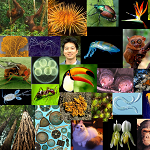
Watch on Vimeo
Summary: Since before Darwin, biologists have sought to understand how the extraordinary diversity of life on earth came to be. We’ve figured out that, when it comes to speciation, it really is all about sex (or rather lack thereof). This talk will explain different speciation mechanisms and the quest to identify ‘speciation genes’, touching on topics such as sperm competition, sexual conflict, and ligers.
Presenter bio: Leslie Turner is a postdoctoral fellow in Genetics at UW-Madison, studying the genetic basis of species barriers in house mice. She’s been an academic nomad for many years, having lived in 6 states and 2 countries during her training. Hopefully she’ll survive the grueling academic job market and end the moving streak someday soon.
Internet Agoraphobia or: Why You Should Be Afraid to Venture Into the World Wide Web

Watch on Vimeo
Summary: The internet has become an integral part of our daily lives — we use it for communication, we make purchases, we upload files. But in this normalcy, do we ever stop and think about where our personal information is going and who might have access to it? Surely if we did, we might want to stay “indoors”. In this talk, you will learn how to best protect yourself from the hazards that await you on the World Wide Web.
Presenter bio: Based in Madison, Rob is a software developer who devotes much of his free time writing FLOSS (free/libre/open source software) and the rest informing people how to practice safe hex (computing, that is). Rob currently works at INOC on the East Side, where he writes web applications and server-side programs.
Cows Shit Gold: The Magic of Manure
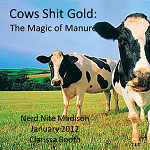
Watch on Vimeo
Summary: “Pasture Patties.” “Cow Pies.” “Meadow Muffins.” No matter its name, cow manure is agricultural gold. For centuries, humans have been using manure as a fertilizer for land. Cow dung is rich in nutrients and microbes eager to unknowingly cultivate farmland. But in addition to its use as a crop dressing, manure has other lesser known applications from serving as an insect repellent to a biofuel. In this talk we’ll learn just how valuable manure is, both historically and to modern science, and hopefully learn plenty of synonyms for “poo” along the way. So grab a stool, take a load off, and let us enrich your pootential.
Presenter bio: Clarissa Booth is an environmental toxicology graduate student at UW. She’s taking care of business by using enzymes from manure and compost to degrade recalcitrant proteins. She frequently collects prairie pancakes to study, but for eating, says blueberry pancakes are her favorite.
Date: Wednesday November 30, 2011
Time: 8pm
Location: Genna’s Lounge (map)
Smut and Sluts: How Reading Novels Will Turn You into a Sex-Crazed Maniac

Watch on Vimeo
Summary: New reading practices and the rise in popularity of the novel caused 18th century moralists to panic that novels might be transforming docile and virtuous women into hysterical nymphomaniacs with no regard for societal rules. Meanwhile, libertine authors were writing—and illustrating—erotic novels with exactly that goal in mind. Can reading really turn you into a sex-obsessed madwoman? Is the novel the first step toward total collapse of civilization? Is this talk just an excuse to display historical porn in public? Discover the dangers of fiction before it’s too late!
Presenter bio: Rachel Tapley is getting her PhD in French literature at UW-Madison. She is writing about seduction and the dangers of reading in 18th and 19th century novels. It is too late for her to benefit from her own warnings.
Sweeeeet! Science! The Chemistry of Candy

Watch on Vimeo
Summary: For milennia, one “spice” has stood tall against the rest, and rightly so. Without sugar, there’d be no candy, which means no Halloween, practically no Valentine’s Day, and thousands fewer good reasons to be obese or diabetic. It’s true, candy has imposed its will upon the weathered fabric of society and taken hold. Issues examined will include the awesome things that candy can do, mechanisms for killing someone with sweetness and how to mitigate chocolate-induced guilt.
Presenter bio: Nick Myllenbeck is a chemistry graduate student at UW and candy enthusiast (he says the sour ones are his type!) Nick enjoys thinking about chemistry that will solve the world’s problems and how Madison should be in California.
The History of the Vibrator

Watch on Vimeo
Summary: Half of Americans have used vibrators during their lifetimes, but few know the history of these pleasure-producing devices. In this talk, you’ll learn that Wisconsin played an important role in the history of the vibrator, while also seeing (and perhaps touching) a 100-year-old working vibrator manufactured in Racine, Wisconsin.
Presenter bio: Hallie Lieberman is the world’s leading (only) dildographer. She’s writing her dissertation on the history of sex toys. To learn more about the fine art of dildography, read her blog at http://www.dildographer.wordpress.com
Date: Wednesday October 19, 2011
Time: 8pm
Location: Genna’s Lounge (map)
The Virology of Werewolfism (Lycanosis): What Werewolves Have in Common with Cold Sores
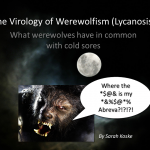
Watch on Vimeo
Summary: This highly publicized and dramatized disease has plagued humanity for centuries, yet little is known about what it is or what we’re supposed to do about it. In this talk you’ll learn the exact modus operandi and strategic plan of the virus that causes werewolfism, and how best to thwart it and save your life and the lives of countless other drifters and people with poor nighttime transportation habits.
Presenter bio: Sarah Koske is a student studying both the rare and more common animal diseases and zoonoses. She has an interest in non-traditional species (including, but not limited to, werewolves), as well as pathology, and the ecology of disease. Unfortunately, Sarah also has an imagination that cannot be controlled with corticosteroids. Sarah has been the winner of the NIH’s coveted “Most Original, Well-written, Yet Inordinately Ludicrous Grant Proposal” award since 2005.
Nerd Nite of the Living Dead: How to Survive a Zombie Apocalypse

Watch on Vimeo
Summary: Do you have a strategy in place to survive zombie attacks? Do you want to be devoured by or converted into one of the living dead? If the answer to both of these questions is no, then you’re in luck. This Nerd Nite presentation will introduce you to the the origins of zombie lore and give you the essential do’s and don’t’s for short-term strategies against individual attacks as well as long-term success in a post-apocalyptic environment.
Presenter bio: Danielle started her zombie-preparedness training through taking courses in the English department at her undergraduate institution, the geographically-confusing Indiana University of Pennsylvania. She is now a PhD candidate in the philosophy department at UW-Madison, working on a dissertation in philosophy of braaaaaaaaaaaains
Sasquatch, Science, and Pseudoscience
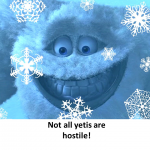
Watch on Vimeo
Summary: Is Bigfoot real or bullshit? By applying basic scientific principles and some biological anthropology, we’ll explore the legend of North America’s famous hirsute bipedal ape. We’ll find out how real scientists out fraudsters and see how fact is more intriguing than fiction.
Presenter bio: Zach Throckmorton is a dissertator at UW-Madison’s Department of Anthropology. He is Madison’s leading (i.e. only) authority on the evolution of the human foot.
Date: Wednesday September 7, 2011
Time: 8pm
Location: Genna’s Lounge (map)
Urination Explanation – What Is Pee and Why Is It So Awesome?!!?!
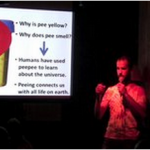
Watch on Vimeo
Summary: Pee!!! Jokes about it will never stop being funny and facts about it will never stop being interesting! This talk will explain what pee is, why it is yellow, why it smells, how it connects us with the rest of life on earth, and how humans have used it to learn more about the nature of the universe. Teaser fact: humans used pee to make the worlds first explosives! Get ready for an unruly undertaking of urinary utterances!
Presenter bio: Lee Bishop is a PhD chemist and professional science enthusiast. When not pushing the boundaries of knowledge in his research as a postdoctoral fellow at UW-Madison he is trying to come up with simple explanations for our complex universe for his blog Science Minus Details. Lee loves to pee.
Mind-Bending Morphology and the Science of Human Language
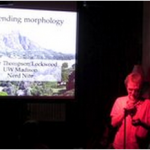
Watch on Vimeo
Summary: Language pervades our reality; whether spoken, written, typed, or signed, language is an inescapable fact of human existence. One of the most basic functions of a human language is to describe events in the world around (and inside of!) us, and so it’s reasonable to start by examining the fundamentals: in a human language, how can you tell who did what to who(m)? This talk will dig beyond familiar European languages to show that the answers to this question are surprisingly diverse!
Presenter bio: Hunter Thompson Lockwood is a graduate student at the University of Wisconsin-Madison who has been speaking human languages in his personal life since the mid-to-late 1980’s. He is currently putting his nerdish obsessions over minutiae to good use by helping the Potawatomi people put together the first real dictionary for their language. In his spare time he rambles to his fiancée and cat.
“Endless Forms Most Beautiful and Most Wonderful” – The Evolution of Penis Morphology
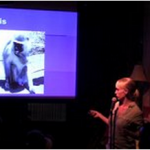
Watch on Vimeo
Summary: Penises are perhaps simultaneously the most studied and least studied adaptations in the animal kingdom. Hobbyists have been examining them for millennia, however until recently, evolutionary biologists have paid little attention. This talk will explore the different selective pressures on penis morphology, with colorful illustrations and explanations of some of nature’s strangest penises. It will conclude by considering how these forces have shaped the human penis.
Presenter bio: Hayley Clatterbuck is a graduate student studying the philosophy of biology at UW-Madison. She is interested in evolutionary biology and anthropology, and she always appreciates a salacious scientific anecdote. Hayley does not have a penis.












